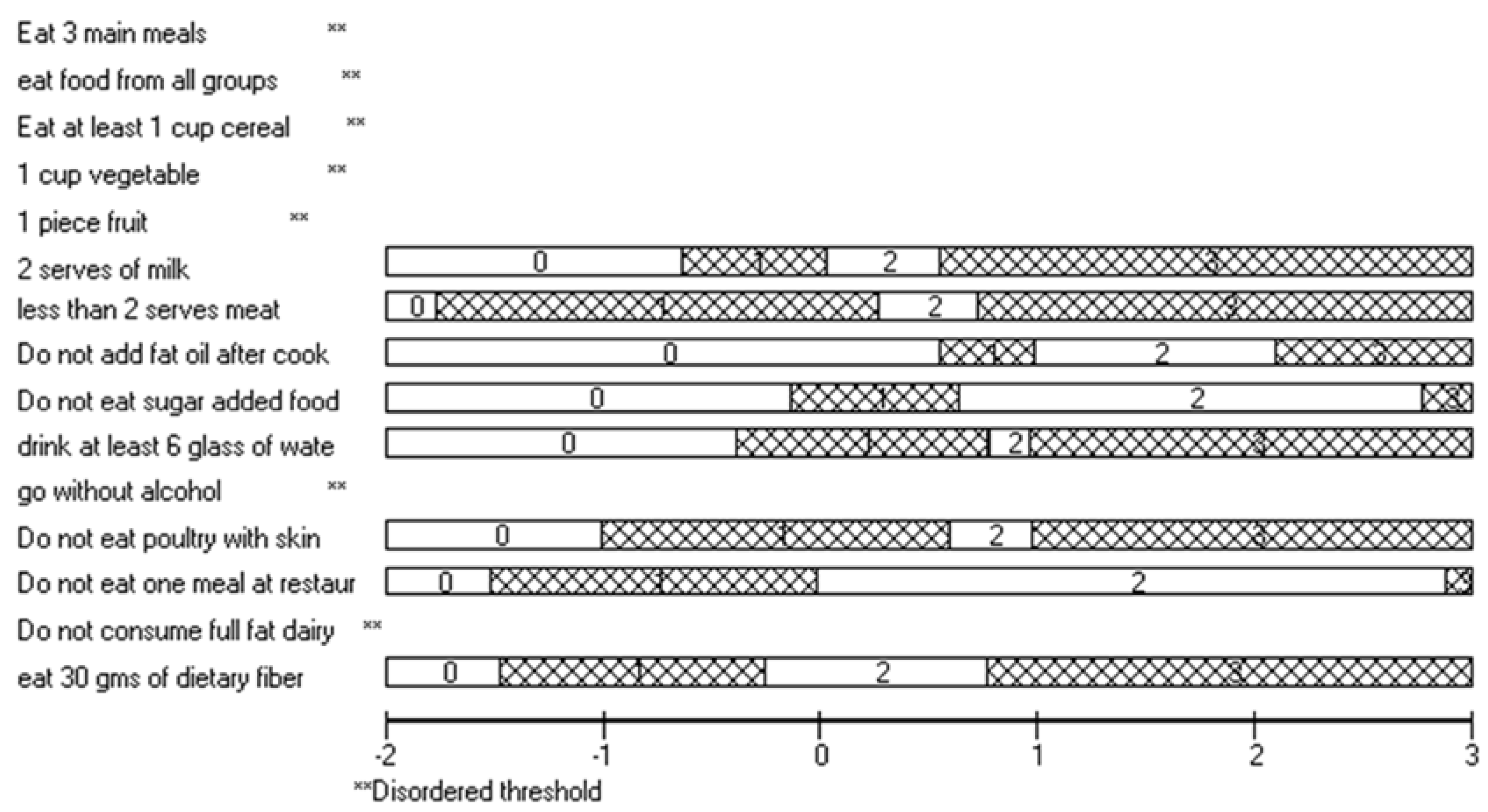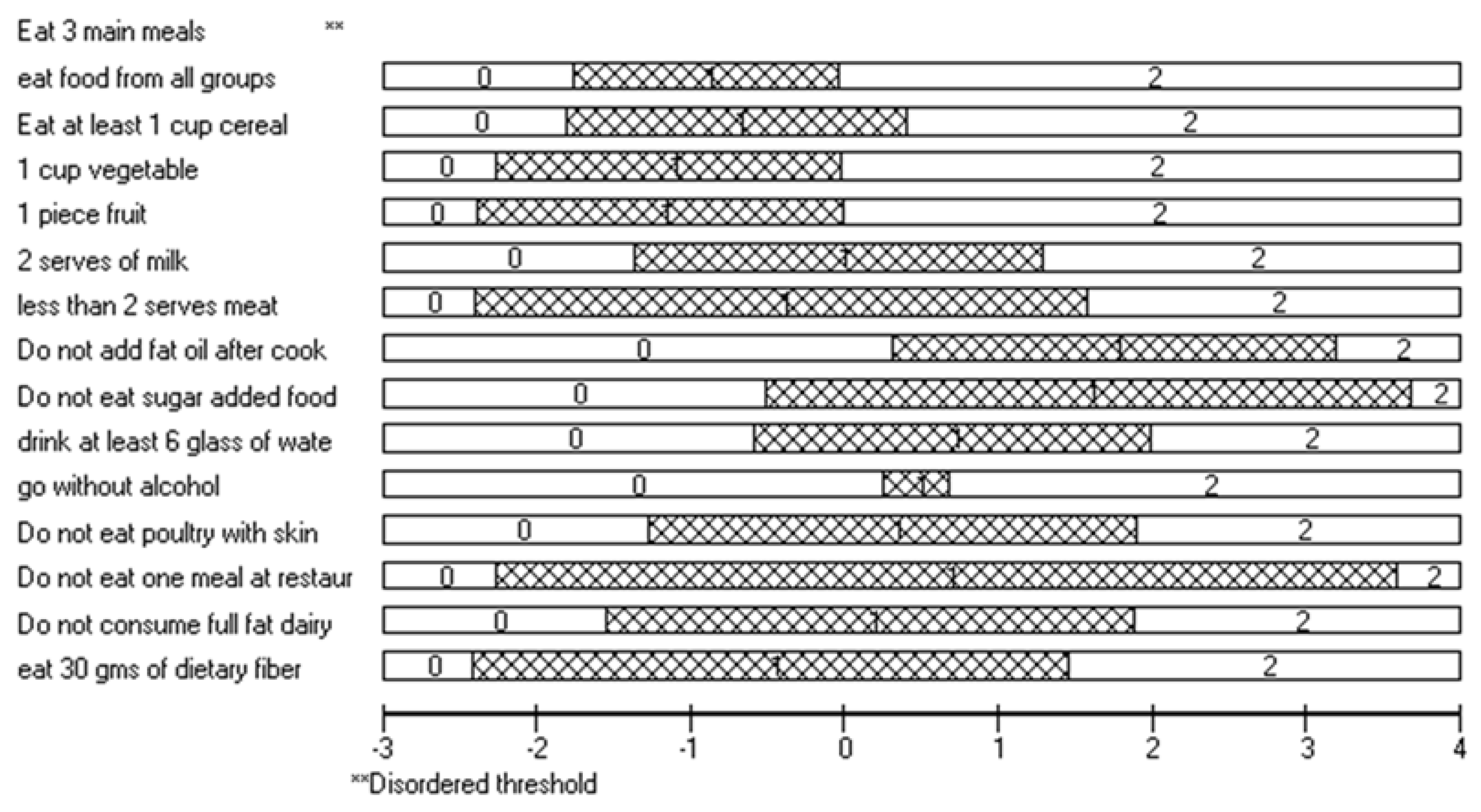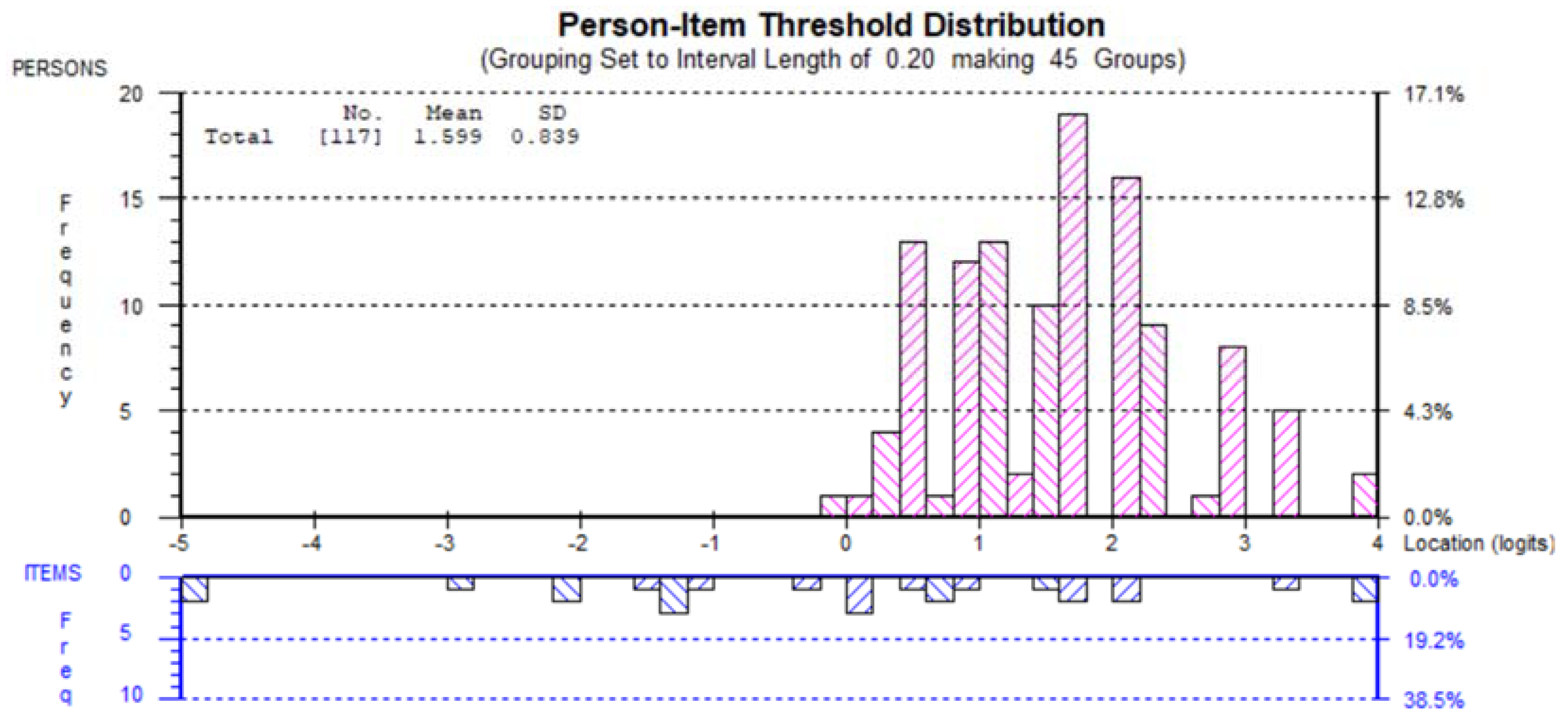An Evaluation of Healthy Eating Scale for Patients with Pre-Diabetes Using Rasch Analysis
Abstract
1. Introduction
2. Materials and Methods
2.1. Participants
2.2. Sample Size
2.3. Introduction to Rasch Model and Data Analysis
3. Results
3.1. Participant Characteristics
3.2. Overall Model Fit/Summary
3.3. Differential Item Functioning (DIF)
3.4. Disordered Threshold/Threshold Curves
3.5. Refinement of Model
3.6. Targeting Person Item Threshold
3.7. Proposed Final Analysis of Items and Three Response Categories
4. Discussion
5. Conclusions
Author Contributions
Funding
Institutional Review Board Statement
Informed Consent Statement
Data Availability Statement
Acknowledgments
Conflicts of Interest
References
- WHO. Diabetes Fact Sheet. Available online: https://www.who.int/news-room/fact-sheets/detail/diabetes (accessed on 18 December 2022).
- Cheung, N.M.D.; Mitchell, P.P.; Wong, T.Y.P. Diabetic retinopathy. Lancet 2010, 376, 124–136. [Google Scholar] [CrossRef] [PubMed]
- International Diabetes Federation. IDF Diabetes Atlas 10th Edition 2021. Available online: https://diabetesatlas.org/idfawp/resource-files/2021/07/IDF_Atlas_10th_Edition_2021.pdf (accessed on 18 December 2022).
- AIHW. Diabetes. Available online: https://www.aihw.gov.au/reports/diabetes/diabetes/contents/how-many-australians-have-diabetes (accessed on 18 December 2022).
- Barnes, P.M.; Adams, P.F.; Powell-Griner, E. Health characteristics of the Asian adult population: United States, 2004–2006. Adv. Data 2008, 394, 1–22. [Google Scholar]
- Gujral, U.P.; Echouffo-Tcheugui, J.B.; Narayan, K.M.V. Commentary: Trends in prevalence of type 2 diabetes and prediabetes in South Asians-does it tell a story? Int. J. Epidemiol. 2011, 40, 1554–1555. [Google Scholar] [CrossRef]
- Wang, E.J.; Wong, E.C.; Dixit, A.A.; Fortmann, S.P.; Linde, R.B.; Palaniappan, L.P. Type 2 diabetes: Identifying high risk Asian American subgroups in a clinical population. Diabetes Res. Clin. Pract. 2011, 93, 248–254. [Google Scholar] [CrossRef]
- Choi, S.E.; Liu, M.; Palaniappan, L.P.; Wang, E.J.; Wong, N.D. Gender and ethnic differences in the prevalence of type 2 diabetes among Asian subgroups in California. J. Diabetes Complicat. 2013, 27, 429–435. [Google Scholar] [CrossRef]
- Centers for Disease Control and Prevention. Diabetes and Asian American People. Available online: https://www.cdc.gov/diabetes/library/spotlights/diabetes-asian-americans.html (accessed on 18 December 2022).
- Office of Minority Health. Diabetes and Asian Americans. Available online: https://minorityhealth.hhs.gov/omh/browse.aspx?lvl=4&lvlid=48 (accessed on 18 December 2022).
- Dunstan, D.W.; Zimmet, P.Z.; Atkins, R.; Shaw, J.E.; Welborn, T.A.; De Courten, M.P.; Cameron, A.J.; Sicree, R.A.; Dwyer, T.; Colagiuri, S.; et al. The rising prevalence of diabetes and impaired glucose tolerance: The Australian Diabetes, Obesity and Lifestyle Study. Diabetes Care 2002, 25, 829–834. [Google Scholar] [CrossRef]
- Nordström, A.; Hadrévi, J.; Olsson, T.; Franks, P.W.; Nordström, P. Higher Prevalence of Type 2 Diabetes in Men Than in Women Is Associated With Differences in Visceral Fat Mass. J. Clin. Endocrinol. Metab. 2016, 101, 3740–3746. [Google Scholar] [CrossRef] [PubMed]
- American Diabetes Association. Diagnosis and classification of diabetes mellitus. Diabetes Care 2012, 37 (Suppl. 1), S81–S90. [Google Scholar] [CrossRef]
- Leiter, L.A.; Barr, A.; Belanger, A.; Lubin, S.; Ross, S.A.; Tildesley, H.D.; Fontaine, N. Diabetes screening in Canada (DIASCAN) Study: Prevalence of undiagnosed diabetes and glucose intolerance in family physician offices. Diabetes Care 2001, 24, 1038–1043. [Google Scholar] [CrossRef]
- King, H.; Rewers, M.; Who Ad Hoc Diabetes Reporting Group. Global Estimates for Prevalence of Diabetes Mellitus and Impaired Glucose Tolerance in Adults. Diabetes Care 1993, 16, 157–177. [Google Scholar] [CrossRef]
- Gu, D.; Reynolds, K.; Duan, X.; Xin, X.; Chen, J.; Wu, X.; Mo, J.; Whelton, P.K.; He, J. Prevalence of diabetes and impaired fasting glucose in the Chinese adult population: International Collaborative Study of Cardiovascular Disease in Asia (InterASIA). Diabetologia 2003, 46, 1190–1198. [Google Scholar] [CrossRef] [PubMed]
- Tapp, R.J.; Zimmet, P.Z.; Harper, C.A.; McCarty, D.J.; Chitson, P.; Tonkin, A.M.; Söderberg, S.; Taylor, H.R.; Alberti, K.G.M.M.; Tuomilehto, J.; et al. Six year incidence and progression of diabetic retinopathy: Results from the Mauritius diabetes complication study. Diabetes Res. Clin. Pract. 2006, 73, 298–303. [Google Scholar] [CrossRef] [PubMed]
- Fletcher, B.; Gulanick, M.; Lamendola, C. Risk Factors for Type 2 Diabetes Mellitus. J. Cardiovasc. Nurs. 2002, 16, 17–23. [Google Scholar] [CrossRef]
- Belkina, A.C.; Denis, G.V. Obesity genes and insulin resistance. Curr. Opin. Endocrinol. Diabetes Obes. 2010, 17, 472–477. [Google Scholar] [CrossRef]
- Asif, M. The prevention and control the type-2 diabetes by changing lifestyle and dietary pattern. J. Educ. Health Promot. 2014, 3, 1. [Google Scholar] [CrossRef] [PubMed]
- Tuomilehto, J.; Lindström, J.; Eriksson, J.G.; Valle, T.T.; Hämäläinen, H.; Ilanne-Parikka, P.; Keinänen-Kiukaanniemi, S.; Laakso, M.; Louheranta, A.; Rastas, M.; et al. Prevention of Type 2 Diabetes Mellitus by Changes in Lifestyle among Subjects with Impaired Glucose Tolerance. N. Engl. J. Med. 2001, 344, 1343–1350. [Google Scholar] [CrossRef]
- Lindström, J.; Aittola, K.; Pölönen, A.; Hemiö, K.; Ahonen, K.; Karhunen, L.; Männikkö, R.; Siljamäki-Ojansuu, U.; Tilles-Tirkkonen, T.; Virtanen, E.; et al. Formation and Validation of the Healthy Diet Index (HDI) for Evaluation of Diet Quality in Healthcare. Int. J. Environ. Res. Public Health 2021, 18, 2362. [Google Scholar] [CrossRef]
- Sami, W.; Ansari, T.; Butt, N.S.; Hamid, M.R.A. Effect of diet on type 2 diabetes mellitus: A review. Int. J. Health Sci. 2017, 11, 65–71. [Google Scholar]
- England, C.Y.; Thompson, J.L.; Jago, R.; Cooper, A.R.; Andrews, R.C. Development of a brief, reliable and valid diet assessment tool for impaired glucose tolerance and diabetes: The UK Diabetes and Diet Questionnaire. Public Health Nutr. 2017, 20, 191–199. [Google Scholar] [CrossRef]
- National Health and Medical Research Council. Dietary Guidelines for Australian Adults. Available online: http://www.nhmrc.gov.au/publications/_files/n33.pdf (accessed on 14 July 2021).
- McNaughton, S.A.; Ball, K.; Crawford, D.; Mishra, G.D. An Index of Diet and Eating Patterns Is a Valid Measure of Diet Quality in an Australian Population. J. Nutr. 2008, 138, 86–93. [Google Scholar] [CrossRef]
- Hackworth, N.; Moore, S.M.; Hardie, E.A.; Critchley, C.; Buzwell, S.; Crafti, N.; Kyrios, M. A Risk Factor Profile for Pre-diabetes: Biochemical, Behavioural, Psychosocial and Cultural Factors. Ejournal Appl. Psychol. 2007, 3. [Google Scholar] [CrossRef]
- Segal-Isaacson, C.J.; Wylie-Rosett, J.; Gans, K.M. Validation of a Short Dietary Assessment Questionnaire: The Rapid Eating and Activity Assessment for Participants Short Version (REAP-S). Diabetes Educ. 2004, 30, 774–781. [Google Scholar] [CrossRef] [PubMed]
- All Children Learning. Classical Test Theory and Item Response Theory. Available online: https://allchildrenlearning.org/assessment-topics/analysing/classical-test-theory-and-item-response-theory/ (accessed on 10 October 2022).
- Frey, F. Test Theory and Classical Test Theory. In The International Encyclopedia of Media Psychology; Wiley: Hoboken, NJ, USA, 2020. [Google Scholar]
- Urbina, S. Essentials of Psychological Testing; John Wiley & Sons Inc: Hoboken, NJ, USA, 2004. [Google Scholar]
- Hu, Z.; Lin, L.; Wang, Y.; Li, J. The Integration of Classical Testing Theory and Item Response Theory. Psychlogy 2021, 12, 1397–1409. [Google Scholar]
- Lewis, C. 2 Selected Topics in Classical Test Theory. In Handbook of Statistics; Rao, C.R., Sinharay, S., Eds.; Elsevier: Amsterdam, The Netherlands, 2006; Volume 26, pp. 29–43. [Google Scholar]
- Bechger, T.; Maris, G.; Verstralen, H.; Béguin, A. Using Classical Test Theory in Combination With Item Response Theory. Appl. Psychol. Meas. 2003, 27, 319–334. [Google Scholar] [CrossRef]
- Brennan, R.L. Generalizability Theory and Classical Test Theory. Appl. Meas. Educ. 2010, 24, 1–21. [Google Scholar] [CrossRef]
- Chen, W.-H.; Lenderking, W.; Jin, Y.; Wyrwich, K.; Gelhorn, H.; Revicki, D. Is Rasch model analysis applicable in small sample size pilot studies for assessing item characteristics? An example using PROMIS pain behavior item bank data. Qual. Life Res. Int. J. Qual. Life Asp. Treat. Care Rehabil. 2013, 23, 485–493. [Google Scholar] [CrossRef]
- Uddin, M.N.; Islam, F.M.A.; Al Mahmud, A. Psychometric evaluation of an interview-administered version of the Kessler 10-item questionnaire (K10) for measuring psychological distress in rural Bangladesh. BMJ Open 2018, 8, e022967. [Google Scholar] [CrossRef]
- D Andrich, B.S.; Luo, G. RUMM2030 Professional 5.4; RUMM Laboratory: Perth, Australia, 2015. [Google Scholar]
- Rummlab. Frequently Asked Questions. Available online: https://www.rummlab.com.au/faqs (accessed on 10 January 2022).
- Institute for Objective Measurement. Rasch Measurement Analysis Software Directory. Available online: https://www.rasch.org/software.htm (accessed on 10 January 2023).
- Rasch, G. An Item Analysis which Takes Individual Differences into Account. Br. J. Math. Stat. Psychol. 1966, 19, 49–57. [Google Scholar] [CrossRef]
- Wind, S.; Hua, C. Rasch Measurement Theory Analysis in R: Illustrations and Practical Guidance for Researchers and Practitioners. Available online: https://bookdown.org/chua/new_rasch_demo2/ (accessed on 10 October 2022).
- An, X.; Yung, Y.-F. Item Response Theory: What It Is and How You Can Use the IRT Procedure to Apply It. Available online: https://support.sas.com/resources/papers/proceedings14/SAS364-2014.pdf (accessed on 10 January 2023).
- Wikipedia Contributors. Rasch Model. Available online: https://en.wikipedia.org/w/index.php?title=Rasch_model&oldid=1131516781 (accessed on 10 October 2022).
- Lamprianou, I.; Athanasou, J.A. A Teacher’s Guide to Educational Assessment; Brill: Leiden, The Netherlands, 2009. [Google Scholar]
- Hays, R.D.; Morales, L.S.; Reise, S.P. Item response theory and health outcomes measurement in the 21st century. Med. Care 2000, 38, 28–42. [Google Scholar] [CrossRef]
- Furr, D.C. Partial Credit and Generalized Partial Credit Models with Latent Regression. Available online: https://mc-stan.org/users/documentation/case-studies/pcm_and_gpcm.html#generalized-partial-credit-model-with-latent-regression (accessed on 19 January 2023).
- Zanon, C.; Hutz, C.S.; Yoo, H.; Hambleton, R.K. An application of item response theory to psychological test development. Psicol. Reflexão E Crítica 2016, 29, 18. [Google Scholar] [CrossRef]
- Hansen, T.; Kjaersgaard, A. Item analysis of the Eating Assessment Tool (EAT-10) by the Rasch model: A secondary analysis of cross-sectional survey data obtained among community-dwelling elders. Health Qual. Life Outcomes 2020, 18, 139. [Google Scholar] [CrossRef]
- Robinson, M.; Johnson, A.M.; Walton, D.M.; MacDermid, J.C. A comparison of the polytomous Rasch analysis output of RUMM2030 and R (ltm/eRm/TAM/lordif). BMC Med. Res. Methodol. 2019, 19, 36. [Google Scholar] [CrossRef] [PubMed]
- Uddin, M.N.; Islam, F.M.A. Psychometric evaluation of the modified Kessler seven-item version (K7) for measuring psychological distress using Rasch analysis: A cross-sectional study in a rural district of Bangladesh. BMJ Open 2020, 10, e034523. [Google Scholar] [CrossRef] [PubMed]
- Brentari, E.; Golia, S. Unidimensionality in the Rasch model: How to detect and interpret. Statistica 2007, 67, 253–261. [Google Scholar] [CrossRef]
- Pallant, J.F.; Tennant, A. An introduction to the Rasch measurement model: An example using the Hospital Anxiety and Depression Scale (HADS). Br. J. Clin. Psychol. 2007, 46, 1–18. [Google Scholar] [CrossRef]
- Engelhard, G. Rasch models for measurement—Andrich D. Appl. Psychol. Meas. 1988, 12, 435–436. [Google Scholar] [CrossRef]
- Bond, T.; Fox, C. Applying the Rasch Model: Fundamental Measurement in the Human Sciences, 2nd ed.; Lawrence Erlbaum Associates Publishers: Mahwah, NJ, USA, 2007. [Google Scholar]
- Adams, R.J.; Wu, M.L.; Wilson, M. The Rasch Rating Model and the Disordered Threshold Controversy. Educ. Psychol. Meas. 2012, 72, 547–573. [Google Scholar] [CrossRef]
- Linacre, J.M. Step disordering and Thurstone thresholds. Rasch Meas. Trans. 1991, 5, 171. [Google Scholar]
- Masters, G.N. A Rasch model for partial credit scoring. Psychometrika 1982, 47, 149–174. [Google Scholar] [CrossRef]
- Linacre, J.M. Optimizing rating scale category effectiveness. J. Appl. Meas. 2002, 3, 85–106. [Google Scholar]
- Tennant, A.; Pallant, J.F. DIF matters: A practical approach to test if differential item functioning makes a difference. Rasch Meas. Trans. 2007, 24, 1082–1084. [Google Scholar]
- Holland, P.W. On the sampling theory foundations of item response theory models. Psychometrika 1990, 55, 577–601. [Google Scholar] [CrossRef]
- Cohen, J. Statistical Power Analysis for the Behavioral Sciences; Routledge Acaedmic: New York, NY, USA, 1988. [Google Scholar]
- Ma, Y. Dairy Product Per Capita Consumption in China 2013–2019. Available online: https://www.statista.com/statistics/1098497/china-per-capita-milk-dairy-consumption/ (accessed on 24 July 2021).
- Davis, B. What Did Ancient Chinese Write On? Available online: https://www.mvorganizing.org/what-did-ancient-chinese-write-on/ (accessed on 24 July 2021).
- Morgan, R. Our Changing Culinary Habits. Available online: http://www.roymorgan.com/findings/7179-our-changing-culinary-habits-attitudes-201703150956 (accessed on 24 July 2021).
- Statistics, A.B.O. Census All Persons QuickStats. Available online: https://www.abs.gov.au/census/find-census-data/quickstats/2021/AUS (accessed on 18 December 2022).




| Gender | |||
|---|---|---|---|
| Characteristic | Total, n = 119 | Male, n = 41 | Female, n = 78 |
| Age group (in years) | |||
| <60 | 35 (29.4%) | 8 (19.5%) | 27 (34.6%) |
| 60–69 | 54 (45.4%) | 19 (46.3%) | 35 (44.9%) |
| 70+ | 30 (25.2%) | 14 (34.1%) | 16 (20.5%) |
| Ethnicity | |||
| Non-Chinese | 99 (83.2%) | 35 (85.4%) | 64 (82.1%) |
| Chinese | 20 (16.8%) | 6 (14.6%) | 14 (17.9%) |
| Fit Residuals Mean (SD) | Item-Trait Interaction | Reliability | ||||
|---|---|---|---|---|---|---|
| Scale Analysis | Item | Person | χ2 (df) | p | PSI | Power of Fit |
| Initial analysis | ||||||
| 1. Full sample (no refinements or alteration) | 0.12 (0.91) | −0.22 (0.98) | 29.29 (30) | 0.500 | 0.57 | Reasonable |
| 2. Chinese only (full sample, no alteration). | 0.41 (0.59) | 0.16 (0.80) | 38.82 (30) | 0.130 | 0.457 | Low |
| 3. Non Chinese only (full sample, no alteration) | 0.10 (0.95) | −0.24 (0.96) | 23.90 (30) | 0.129 | 0.585 | Reasonable |
| Analysis after reducing to three scoring categories | ||||||
| 1. Scoring structure 0112 for all items | −0.14 (0.70) | −0.33 (1.03) | 37.36 (30) | 0.166 | 0.55 | Reasonable |
| Analysis after removing items and persons (last resort) | ||||||
| 1. Scoring Structure 0112 delete item 1 only (disordered) | −0.10 (0.61) | −0.33 (1.10) | 37.91 (28) | 0.100 | 0.511 | Reasonable |
| 2. Scoring structure 0112 delete item 10 and ID 193 161 | −0.17 (0.52) | −0.32 (0.97) | 32.31 (28) | 0.262 | 0.559 | Reasonable |
| 3. Scoring structure 0112 delete item 1 &10 and ID 193 161 | −0.12 (0.40) | −0.31 (1.05) | 27.49 (26) | 0.384 | 0.525 | Reasonable |
| Optimal values | 0 (1.00) | 0 (1.00) | >0.05 | >0.70 | ||
| Factors | Factor Comparison | Difference in Mean (95% CI) Logit | p | Cohen’s d |
|---|---|---|---|---|
| Ethnicity | Non-Chinese vs. Chinese | 0.35 (0.09, 0.61) | 0.008 | 0.66 |
| Gender | Female vs. Male | 0.09 (−0.12, 0.30) | 0.41 | 0.16 |
| Age group | 60 and older vs. younger than 60 years | 0.11 (−1.26, 0.35) | 0.35 | 0.21 |
| Chinese Participant | Sex | ||||
|---|---|---|---|---|---|
| Non-Chinese | Chinese | Male | Female | ||
| Count | Count | Count | Count | ||
| 2 serves of milk | Never | 1 | 4 | 3 | 2 |
| Rarely | 9 | 9 | 8 | 10 | |
| Some days | 31 | 5 | 14 | 22 | |
| Usually/most days | 57 | 2 | 16 | 43 | |
| Drink at least 6 glasses of water | Never | 11 | 0 | 5 | 6 |
| Rarely | 30 | 4 | 15 | 19 | |
| Some days | 29 | 7 | 10 | 26 | |
| Usually/most days | 29 | 9 | 11 | 27 | |
Disclaimer/Publisher’s Note: The statements, opinions and data contained in all publications are solely those of the individual author(s) and contributor(s) and not of MDPI and/or the editor(s). MDPI and/or the editor(s) disclaim responsibility for any injury to people or property resulting from any ideas, methods, instructions or products referred to in the content. |
© 2023 by the authors. Licensee MDPI, Basel, Switzerland. This article is an open access article distributed under the terms and conditions of the Creative Commons Attribution (CC BY) license (https://creativecommons.org/licenses/by/4.0/).
Share and Cite
de Vent, K.A.; Do, N.H.N.; Islam, F.M.A. An Evaluation of Healthy Eating Scale for Patients with Pre-Diabetes Using Rasch Analysis. Appl. Sci. 2023, 13, 2050. https://doi.org/10.3390/app13042050
de Vent KA, Do NHN, Islam FMA. An Evaluation of Healthy Eating Scale for Patients with Pre-Diabetes Using Rasch Analysis. Applied Sciences. 2023; 13(4):2050. https://doi.org/10.3390/app13042050
Chicago/Turabian Stylede Vent, Kerry Anne, Nguyen Hoang Nguyen Do, and Fakir M. Amirul Islam. 2023. "An Evaluation of Healthy Eating Scale for Patients with Pre-Diabetes Using Rasch Analysis" Applied Sciences 13, no. 4: 2050. https://doi.org/10.3390/app13042050
APA Stylede Vent, K. A., Do, N. H. N., & Islam, F. M. A. (2023). An Evaluation of Healthy Eating Scale for Patients with Pre-Diabetes Using Rasch Analysis. Applied Sciences, 13(4), 2050. https://doi.org/10.3390/app13042050






